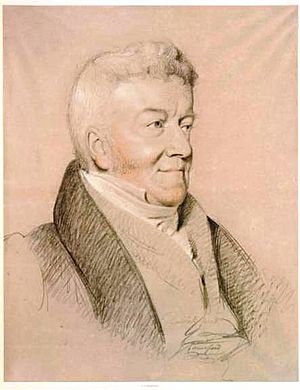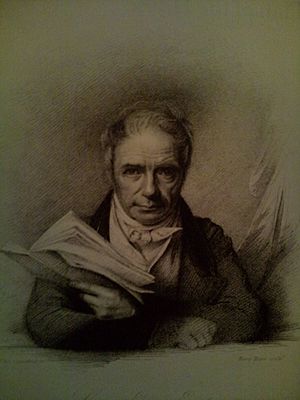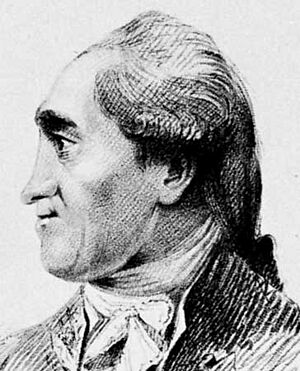John Comerford facts for kids
Quick facts for kids
John Comerford
|
|
|---|---|

Self portrait
|
|
| Born | circa 1770 |
| Died | 25 January 1832 (aged 61–62) |
| Nationality | Irish |
John Comerford (1770–1832) was a famous miniature painter from Ireland. A miniature painter creates very small, detailed portraits, often on ivory or vellum.
Contents
Early Life and Art School
John Comerford was born in Kilkenny, Ireland, around 1770. His father worked with flax, a plant used to make linen. Young John grew up near the Tholsel, a historic building in Kilkenny.
He first learned about art by copying paintings. These paintings were part of the collection at Kilkenny Castle. This early practice helped him develop his skills.
Later, John moved to Dublin to study art more seriously. He joined the art schools of the Dublin Society. In 1790, he was praised for his "extraordinary merit" in drawing. The next year, he won a medal for his figure-drawing.
Becoming a Professional Artist
John Comerford started his career painting in Kilkenny and nearby areas. He also worked in Dublin. Some of his first paintings were of his own family members. He also painted important people like Lady Dunsany.
He painted portraits for the Dublin Society, including Thomas Braughall and Dr Edward Walsh. His portrait of Dr. Walsh was later used in a magazine.
At first, his art style was similar to American painter Gilbert Stuart. Later, he was influenced by the English artist George Chinnery.
Working with George Chinnery
In 1799, Comerford met George Chinnery. In 1800, Comerford even moved into Chinnery's home in Dublin. For the next 15 years, they often lived together when Chinnery visited Dublin.
Chinnery helped Comerford's career. He included Comerford's work in an art exhibition in 1800. People were very impressed. One newspaper wrote, "Here is an artist whom we never saw or ever before so much as heard of. Our astonishment at his pictures must excuse this note of admiration."
Comerford continued to show his work in Dublin in 1801 and 1802. He quickly became known as a top miniature painter.
Success and Famous Portraits
In 1811, Comerford became the vice-president of the Society of Artists. He showed his art in Dublin until 1814. He also exhibited his paintings in London at the Royal Academy in 1804 and 1809.
He became very successful and well-known in Dublin. He had many clients who wanted their portraits painted. He was especially good at painting men. His portraits were detailed, expressive, and had calm colors.
John Comerford continued to visit Kilkenny. In 1808, he painted 11 portraits of actors from the Kilkenny Private Theatre. These paintings were later used in a book.
He was a popular artist. Many important people asked him to paint them. These included landowners, military officers, and religious leaders. He also painted famous figures like Daniel O'Connell, James Gandon, and Richard Lovell Edgeworth. Many of his portraits were later made into engravings for magazines.
An Influential Artist
In 1819, there was a disagreement among artists in the Dublin Society. They were discussing whether the society should become an official organization. John Comerford was chosen to speak for one side because he was well-respected. Even though his side didn't win, he was a key figure in the art community. He never joined the Royal Hibernian Academy later on.
Comerford painted portraits of his close friends, like Vincent Waldré and William Ashford. He also worked with other artists such as William Cuming.
He was also a teacher to many artists, including John Doyle. He greatly influenced artists like Samuel Lover. John Comerford was very successful and retired with a large amount of money.
Later Life and Legacy
John Comerford passed away on January 25, 1832, at his home in Dublin. He had suffered a stroke while visiting his friend James Gandon. He had one daughter, Mary, and left her a good income.
His work continued to be admired. Some of his paintings were shown at a special exhibition in 1865. You can find examples of his miniature portraits in museums today, like the Victoria and Albert Museum in London.



